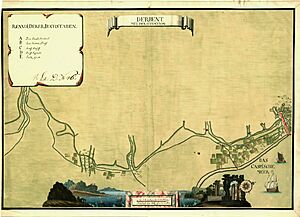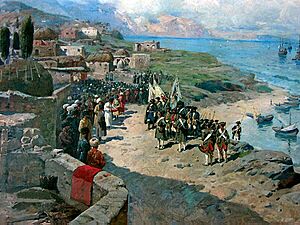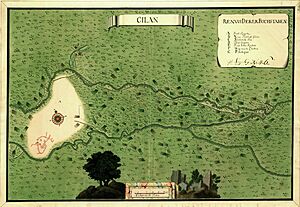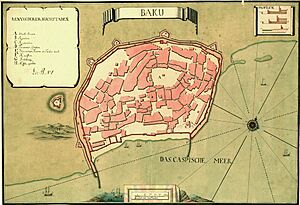Russo-Persian War (1722–1723) facts for kids
Quick facts for kids Russo-Persian War (1722–1723) |
|||||||||
|---|---|---|---|---|---|---|---|---|---|
| Part of Russo-Persian Wars | |||||||||
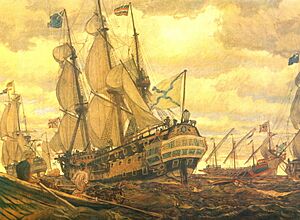 Peter the Great's fleet |
|||||||||
|
|||||||||
| Belligerents | |||||||||
|
|
|||||||||
| Commanders and leaders | |||||||||
Ayuka Khan Adil-Giray Rustam-Qadi |
|||||||||
| Strength | |||||||||
| Russian Army: 61,039 | Unknown | ||||||||
| Casualties and losses | |||||||||
| 36,664 Russian army deaths | Unknown | ||||||||
The Russo-Persian War of 1722–1723 was a conflict between the Russian Empire and Safavid Iran. In Russia, it was known as the Persian campaign of Peter the Great.
The war started because Peter the Great, the Russian ruler, wanted to expand Russia's power. He aimed to gain more influence around the Caspian Sea and in the Caucasus region. He also wanted to stop the Ottoman Empire, a rival, from taking land from the weakening Safavid Iran.
Russia won the war. This meant that Iran had to give up some of its lands to Russia. These areas included the cities of Derbent and Baku, and provinces like Gilan, Shirvan, Mazandaran, and Astarabad. This was all agreed upon in the Treaty of Saint Petersburg (1723).
However, Russia only held onto these lands for about nine to twelve years. Later, through the Treaty of Resht (1732) and the Treaty of Ganja (1735), these territories were returned to Iran.
Contents
Why the War Started
Before this war, Russia's official border was the Terek River. South of this river, smaller states in Dagestan were loyal to Iran. The main reason for the war was Russia's wish to expand its territory to the southeast. Iran was also very weak at the time. Its capital city was even under attack.
The official reason for the war was the harm done to Russian merchants. In 1721, rebels from within the Safavid Empire attacked and looted the city of Shamakhi. Many people, including Russian merchants, were killed.
Artemy Volynsky, Russia's ambassador to Iran, told Peter the Great about the damage. He said this attack broke a trade agreement from 1717. In that agreement, Iran promised to protect Russian citizens. Since Iran was in chaos and couldn't protect the merchants, Volynsky suggested that Peter invade. He said Russia could pretend to be helping the Iranian king restore order. Russia soon used this attack on its merchants as the reason to start the war.
Getting Ready for War
Between 1714 and 1720, Russian sailors had already created maps of the Caspian Sea. On July 15, 1722, Peter the Great released a statement in different languages. It explained why Russia was invading.
Peter gathered a large army: 22,000 foot soldiers, 9,000 cavalry, and 70,000 Cossacks, Tatars, and Kalmyks. To move his army, he created the Caspian Flotilla (a small navy) at Astrakhan. The foot soldiers, cannons, and supplies were sent by sea. The cavalry traveled by land from Tsaritsyn and Mozdok. By the time Peter was ready to attack, the Safavid state in Iran was already falling apart.
The Campaign Begins
Historians often use "old style" dates from Russian records. We will also show the "new style" dates, which are 11 days later.
First Part: 1722
The Russian fleet arrived at the mouth of the Sulak River on July 27, 1722 (August 7, new style). Peter the Great was the first to step ashore. There, he learned that some of his cavalry had been defeated by local fighters at Endirey. Peter sent a group of Kalmyk troops to punish them.
He continued south and set up camp where the city of Petrovsk is today. On August 12 (August 23, new style), he entered Tarki, the capital of the Shamkhalate of Tarki. The local ruler welcomed him as a friend. The next day, Peter headed south towards Derbent, with his fleet sailing along the coast.
He sent messengers to the next important ruler, the Sultan of Utemish. But Sultan Mahmoud Otemishsky killed the messengers. He gathered about 16,000 men to block Peter's path at Utemish. The mountain fighters fought bravely, but they couldn't stop the well-trained Russian soldiers. Utemish was burned, and all prisoners were executed to get revenge for the murdered messengers.
When the Khan of Derbent heard about this, he offered Peter the keys to his city on August 23 (September 3, new style). Derbent is a very important city because it sits at a narrow point on the coast. It has long been seen as the northern gateway to Iran.
While in Derbent, Peter learned that a storm had hit his fleet. Most of his supplies were lost. Since it was too late in the season to get more supplies, he left a strong group of soldiers in Derbent. He then marched back to the Terek River, took a ship to Astrakhan, and made a grand entry into Moscow on December 13 (December 24, new style).
Meanwhile, Vakhtang VI of Kartli (from central Georgia) was a ruler loyal to Iran. He had been held captive by them for seven years. Seeing Iran's weakness, he made a deal with Russia. In September 1722, he moved his forces towards Ganja. But when the Russians didn't join him, he went back to Tbilisi in November. This action angered Iran and led to a terrible invasion of his own country later.
Second Part: 1722 and 1723
Before leaving Astrakhan, Peter sent Colonel Shipov and two groups of soldiers south. On November 6 (November 17, new style), they were sent to take the Iranian city of Rasht at the southwest corner of the Caspian Sea. The local people first wanted help against invading Afghan forces. But they quickly changed their minds.
About 15,000 local fighters gathered. Shah Tahmasp ordered the Russians to leave in February. But by the end of March, the Russians defeated the Iranians and took control of Rasht.
After a long attack, General Matyushkin captured the Iranian city of Baku on June 26, 1723 (July 7, new style). Soon after, he took Shirvan to the west. Then, he captured the three Iranian provinces along the southern coast of the Caspian Sea.
On September 12 (September 23, new style), Russia and Iran signed a treaty. In this agreement, Russia promised to drive out the Afghans and help Shah Tahmasp get his throne back. In return, Iran would give Russia Derbent, Baku, and the three southern coastal provinces. The next year, a Russian prince went to Iran, but he couldn't get the treaty officially approved and was almost killed.
The war officially ended with the Treaty of Saint Petersburg (1723). This treaty recognized that Russia had taken control of the western and southern coasts of the Caspian Sea. Later, the Treaty of Constantinople (1724) was signed. In this treaty, Russia agreed that Turkey could control almost all the land west of what Russia had captured. This basically divided the Transcaucasia region between Russia and Turkey.
Many Russian soldiers died from disease during this time. At the same time, Nader Shah began to make Iran strong again. In 1732, through the Treaty of Resht, Russia pulled back its borders to roughly where Iran's border is today. In 1735, because of the Treaty of Ganja, Russia pulled back even further to its old border along the Terek River.
What Happened After the War
The war was very costly for both sides. Iran lost a lot of its land. Russia lost many soldiers. Out of 61,039 men who fought, 36,663 did not return. The Russians also caused a lot of damage in the areas they occupied. For example, in Gilan, the silk industry quickly declined because many people involved in it fled. It took years for the industry to recover.
Peter the Great wanted to keep the newly conquered Iranian lands. He ordered the forts at Derbent and Holy Cross to be made stronger. He was determined to add Gilan and Mazandaran to Russia. In May 1724, Peter wrote to his commander in Rasht. He told him to invite Armenians and other Christians to settle in Gilan and Mazandaran. He also said that Muslims should be quietly reduced in number as much as possible, without them knowing it.
In 1732, before the Russo-Turkish War (1735–1739) began, Empress Anna Ioannovna (Peter's successor) returned many of the lands to Iran. This was part of the Treaty of Resht. Russia wanted to form an alliance with the Safavids against the Ottoman Empire. By the 1735 Treaty of Ganja, the remaining lands were returned, including Derbent, Baku, and Tarki. Iran was once again in full control of its territories. However, Russian troops did not fully leave the Iranian provinces until 1734.
Historians note that perhaps the only lasting effect for Russia was the memory. Russian rulers remembered that their armies had once marched beyond the Caucasus and that the Russian flag had flown over the southern Caspian Sea.
However, the war had bad results for the Georgian rulers who had supported Peter. In eastern Georgia, Vakhtang VI of Kartli lost his throne and sought protection from Russia in 1724. In western Georgia, Alexander V of Imereti had to accept stricter control from the Ottoman Empire. The Ottomans, worried by Russia's actions, also strengthened their control along the Caucasian coastline.
See also
- Treaty of Constantinople (1724)
- Russo-Persian Wars
- History of the Russo-Turkish wars


